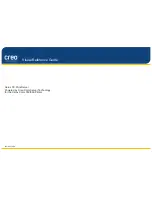
Firmware Checkpoints
Firmware uses checkpoints (progress codes) in the range of Exxx to EFFF. These checkpoints occur
during system startup and can be useful in diagnosing certain problems. Service processor checkpoints
are listed in “Service Processor Checkpoints” on page 310.
If you have a checkpoint with no location code associated with it, see “Determining Location Code” on
page 347. If a checkpoint has a location code associated with a FRU replacement, see “AIX and Physical
Location Code Reference Tables” on page 57 for physical location information.
If you replace FRUs and the problem is still not corrected, go to “MAP 1542: I/O Problem Isolation” on
page 261 unless otherwise indicated in the tables.
Note:
If you receive a four-digit code in the range of E1xx to EFFF that is not listed in the following table,
go to “MAP 1542: I/O Problem Isolation” on page 261.
Table 2. Firmware Checkpoints
Checkpoint
Description
Action/
Possible Failing FRU
E101
Create RTAS node
Go to “MAP 1540: Problem Isolation
Procedures” on page 253.
E102
Load/Init RTAS
Go to “MAP 1540: Problem Isolation
Procedures” on page 253.
E105
Transfer control to Operating System
(normal boot).
See “Boot Problems” on page 342.
E10A
Load RTAS device tree
Go to “MAP 1540: Problem Isolation
Procedures” on page 253.
E10B
Set RTAS device properties
Go to “MAP 1540: Problem Isolation
Procedures” on page 253.
E111
GOOD CRC - jump to composite image
Go to “MAP 1540: Problem Isolation
Procedures” on page 253.
E120
Initialize I/O and early memory block
Go to “MAP 1540: Problem Isolation
Procedures” on page 253.
E121
Initialize service processor
Go to “MAP 1540: Problem Isolation
Procedures” on page 253.
E122
RTAS sensor setup complete
Go to “MAP 1540: Problem Isolation
Procedures” on page 253.
E130
Build device tree
Go to “MAP 1540: Problem Isolation
Procedures” on page 253.
E131
Build device tree
Go to “MAP 1540: Problem Isolation
Procedures” on page 253.
E132
Build device tree, just before setting up root
node
Go to “MAP 1540: Problem Isolation
Procedures” on page 253.
E133
Build device tree, just before setting up
CPUs
Go to “MAP 1540: Problem Isolation
Procedures” on page 253.
E134
Create memory node
Go to “MAP 1540: Problem Isolation
Procedures” on page 253.
E135
Configuring memory nodes
Go to “MAP 1540: Problem Isolation
Procedures” on page 253.
E138
Create options node
Go to “MAP 1540: Problem Isolation
Procedures” on page 253.
Chapter 4. Checkpoints
317
Summary of Contents for pSeries 670
Page 1: ...pSeries 670 Service Guide SA38 0615 03 ERserver...
Page 2: ......
Page 3: ...pSeries 670 Service Guide SA38 0615 03 ERserver...
Page 12: ...x Eserver pSeries 670 Service Guide...
Page 16: ...xiv Eserver pSeries 670 Service Guide...
Page 18: ...xvi Eserver pSeries 670 Service Guide...
Page 324: ...Yes Go to Step 154A 14 on page 302 304 Eserver pSeries 670 Service Guide...
Page 718: ...698 Eserver pSeries 670 Service Guide...
Page 848: ...L3 Cache Shorts Test Step 4 828 Eserver pSeries 670 Service Guide...
Page 849: ...L3 Cache Shorts Test Step 5 Chapter 9 Removal and Replacement Procedures 829...
Page 851: ...L3 Cache Shorts Test Step 2 Chapter 9 Removal and Replacement Procedures 831...
Page 853: ...L3 Cache Shorts Test Step 4 Chapter 9 Removal and Replacement Procedures 833...
Page 854: ...L3 Cache Shorts Test Step 5 834 Eserver pSeries 670 Service Guide...
Page 971: ...7040 Model 671 Media Subsystem 1 2 3 4 5 6 7 8 9 10 Chapter 10 Parts Information 951...
Page 973: ...Power and SCSI Cables to the Media Subsystem 1 2 3 5 4 6 Chapter 10 Parts Information 953...
Page 986: ...966 Eserver pSeries 670 Service Guide...
Page 990: ...970 Eserver pSeries 670 Service Guide...
Page 1018: ...998 Eserver pSeries 670 Service Guide...
Page 1020: ...1000 Eserver pSeries 670 Service Guide...
Page 1028: ...1008 Eserver pSeries 670 Service Guide...
Page 1031: ......
















































